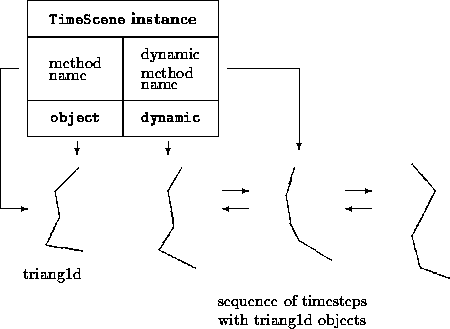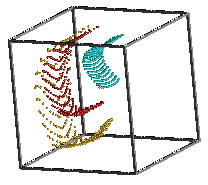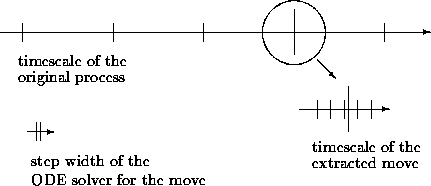In the introductional section we have described the application of static
visualization techniques on time cuts of dynamical processes.
But these visualization techniques on time cuts are not the only possible
approaches to get a deeper insight into the behaviour of interesting
phenomena
in time. A different approach examines integrated evaluations on the process.
They are also of great importance in numerical approaches based
on the method of characteristics.
Let us think for example of a flow problem,
where a vector field v describes the movement of
particles or sets of the latter in time. In detail this means that a
particle x at time ![]() in a domain g moves according to the
first order differential equation
in a domain g moves according to the
first order differential equation ![]() with the initial condition
with the initial condition ![]() .
The stationary visualization methods allow us to inspect this field at
certain times from the point of view of a fixed observer,
where we can interactively vary time and method parameters in
the way it is described in other sections.
In comparison to that the integration
techniques let us have a closer look on the evolution itself. This means
we follow sets of particles in time and record there behaviour
in some sense in terms of a moving observer. In the framework of
continuum mechanics these two different visualization approaches
reflected the two main
different coordinate systems, the Lagrangian and the Eulerian coordinates.
Now using the integration technique we have two possibilities at hand.
The first and standard one is to record only the trace of a set of particles
and throw away the time information.
The second gives us a complete overview on the movement of the specific
set of particles in time. Therefore we extract the movement
again as a dynamical process. This new dynamical process then contains
the positions and the corresponding times of one
particles or of a set of particles,
a curve or a surface. We can look at this as a subset of
the information of the initial process
in which we have performed the integration.
Although these two approaches
look different from the rendering point of view
they can be condensed in one calculation
operation.
.
The stationary visualization methods allow us to inspect this field at
certain times from the point of view of a fixed observer,
where we can interactively vary time and method parameters in
the way it is described in other sections.
In comparison to that the integration
techniques let us have a closer look on the evolution itself. This means
we follow sets of particles in time and record there behaviour
in some sense in terms of a moving observer. In the framework of
continuum mechanics these two different visualization approaches
reflected the two main
different coordinate systems, the Lagrangian and the Eulerian coordinates.
Now using the integration technique we have two possibilities at hand.
The first and standard one is to record only the trace of a set of particles
and throw away the time information.
The second gives us a complete overview on the movement of the specific
set of particles in time. Therefore we extract the movement
again as a dynamical process. This new dynamical process then contains
the positions and the corresponding times of one
particles or of a set of particles,
a curve or a surface. We can look at this as a subset of
the information of the initial process
in which we have performed the integration.
Although these two approaches
look different from the rendering point of view
they can be condensed in one calculation
operation.

Figure 7.1: example of tracing

Let us call it moving. Moving always produces a
time dependent process move
containing the evolution (the movement) of the specific
set in space we are interested in.
This process is again an instance of class TimeScene.
Visualizing this as a trace or as time cuts of the move
is then a question of the "display" method on the new
process and not of the calculation.
In details this means we always calculate moves and then we render them
in two different ways.
Up to now we only know display methods working
on Scene or TimeScene objects, this means on time cuts of the evolution
process move. Regarding the possibility to define a "display" method
named dynamic_method_name
working on the instance variable dynamic,
as it is mentioned in the previous
section in the description on TimeScene,
allows us to display the trace of the process move.
We will call this kind of rendering tracing.
To be more explicit let us briefly examine the underlying equation. If ![]() is the set to be
moved in the field v defined on
is the set to be
moved in the field v defined on ![]() we want to calculate a one parameter
family of sets S(t) which is defined as follows
we want to calculate a one parameter
family of sets S(t) which is defined as follows
![]()
If S(t) consists of only one point we discretize the differential equation
in time. What is actually used is a variant of the second order Euler Cauchy
scheme. With the general well known Euler Cauchy scheme we mean the following
second order one step ODE method. Its local consistency is of order
![]() .
.

We will use the ![]() for the small timestep width
in the ODE scheme. Further on we will not store
all these timestep but only a few of them. This is possible because of the
interpolation techniques working on this list of steps.
We will call this larger step
width
for the small timestep width
in the ODE scheme. Further on we will not store
all these timestep but only a few of them. This is possible because of the
interpolation techniques working on this list of steps.
We will call this larger step
width ![]() but underlining that it does not depend on the timestep of
the process in which we move.
The main disadvantage of this standard ODE scheme working on mesh data is that
it ignores the special structure of the mesh. The scheme above for example has
a consistency error of
but underlining that it does not depend on the timestep of
the process in which we move.
The main disadvantage of this standard ODE scheme working on mesh data is that
it ignores the special structure of the mesh. The scheme above for example has
a consistency error of ![]() if the data is smooth.
But the vectorfield which is in our case the data is in general not smooth. For
viscous flow problems attacked by conforming Finite Element strategies
it is
only
if the data is smooth.
But the vectorfield which is in our case the data is in general not smooth. For
viscous flow problems attacked by conforming Finite Element strategies
it is
only ![]() at the edges or boundary surfaces of
the elements and for highly inviscous flow numerics
and non-conforming Finite Elements
it is even worse. We find smoothness only in the interior of the elements.
This shows that the standard ODE solves are useless for general situations
on discrete meshes. A typical example for the failure of this straightforward
approach is the calculation of particle traces passing a shock
with a shift in the velocity where according to an adaptation strategy
the shock area is intensively refined.
The modified scheme we use overcomes this problem. It has a local consistency
order of
at the edges or boundary surfaces of
the elements and for highly inviscous flow numerics
and non-conforming Finite Elements
it is even worse. We find smoothness only in the interior of the elements.
This shows that the standard ODE solves are useless for general situations
on discrete meshes. A typical example for the failure of this straightforward
approach is the calculation of particle traces passing a shock
with a shift in the velocity where according to an adaptation strategy
the shock area is intensively refined.
The modified scheme we use overcomes this problem. It has a local consistency
order of
![]()
where h is a local upper bound of the discretizations in space. Fore details
we refer to a forthcoming paper.
Now we should turn to
the general case were S(t) is no longer a single point.
We discretize in space the set S by a triangulated approximation
![]() were
were ![]() is a bound for the size of the simplices. Each
vertex point of this set will then be moved according to the ODE scheme
mentioned above. This defines sets
is a bound for the size of the simplices. Each
vertex point of this set will then be moved according to the ODE scheme
mentioned above. This defines sets ![]() which should
approximate
which should
approximate ![]() . The initial approximation error of
. The initial approximation error of
![]() with respect to a smooth set S is of the order
with respect to a smooth set S is of the order ![]() .
But without any mesh adaptation
on the meshes
.
But without any mesh adaptation
on the meshes ![]() we can in general not suppose
we can in general not suppose
![]() to be a good
approximation of S(t). Therefore we apply an adaptive strategy to
refine the discretizations at each timestep following the lines of the adaptive
algorithm described in section about dynamical processes and starting with
to be a good
approximation of S(t). Therefore we apply an adaptive strategy to
refine the discretizations at each timestep following the lines of the adaptive
algorithm described in section about dynamical processes and starting with
![]() .
.
![]()
Here OneStep is one iteration of the described ODE scheme on the vertex points based on the modified EulerCauchy scheme.
![]()
Here the AdaptMesh has to keep aware of degenerating angles as well as of enlarging elements. Let us finally resume that the time scales of the original process and of an arbitrary extracted move process are totally independent.

Figure 7.2: the different scales
Copyright © by the Sonderforschungsbereich 256 at the Institut für Angewandte Mathematik, Universität Bonn.